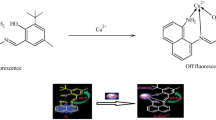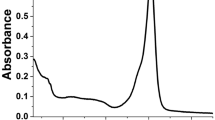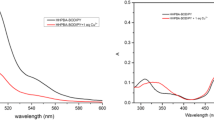Abstract
3-Pyrrolyl BODIPY-Schiff base conjugate was synthesized by treating α-formyl 3-pyrrolyl BODIPY with o-hydroxy aniline in ethanol at reflux followed by recrystallization. The conjugate was thoroughly characterized by HR-MS, 1D & 2D NMR and X-ray crystallography. The X-ray analysis revealed that the BODIPY core was in planar arrangement, with the central boron atom coordinated with two pyrrole nitrogens of dipyrrin moieties and two axial fluoride ions in a tetrahedral geometry. The 3-pyrrolyl BODIPY-Schiff base conjugate exhibited a strong absorption band at 616 nm and broad weak fluorescence band at 660 nm. The absorption and fluorescence titration studies with various metal ions revealed that 3-pyrrolyl BODIPY can act as colorimetric optical sensor and specific “off-on” fluorescent sensor for Cu2+ ion.
Graphical abstract
SYNOPSIS: 3-Pyrrolyl BODIPY-Schiff base conjugate was synthesized starting from α-formyl 3-pyrrolyl BODIPY. The conjugate was thoroughly characterized by HR-MS, NMR and X-ray crystallography. The absorption and fluorescence titration studies with various metal ions revealed that 3-pyrrolyl BODIPY can act as specific “off-on” fluorescent sensor for Cu2+ ion.







Similar content being viewed by others
References
Turski M L and Thiele D J 2008 New Roles for Copper Metabolism in Cell Proliferation, Signaling, and Disease J. Biol. Chem. 284 717
Cotruvo J A, Aron A T, Ramos-Torres K M and Chang C J 2015 Synthetic Fluorescent probes for studying copper in biological systems Chem. Soc. Rev. 44 4400
Liu S, Wang Y and Han J 2017 Fluorescent chemosensors for copper(II) ion: Structure, mechanism and application JPPC 32 78
Gaggelli E, Kozlowski H, Valensin D and Valensin G 2006 Copper Homeostasis and Neurodegenerative Disorders (Alzheimer’s, Prion, and Parkinson’s Diseases and Amyotrophic Lateral Sclerosis) Chem Rev. 106 1995
Bertini I and Rosato A 2008 Menkes disease Cell. Mol. Life Sci. 65 89
Hung Y H, Bush A I and Cherny R A 2010 Copper in the brain and Alzheimer’s disease J. Biol. Inorg. Chem. 15 61
Gupta V K, Singh L P, Singh R, Upadhyay N, Kaur S P and Sethi B 2012 A Novel Copper (II) selective sensor based on Dimethyl 4,4′ (o-phenylene)bis(3-thioallophanate) in PVC matrix J. Mol. Liq. 174 11
Quang D T and Kim J S 2010 Fluoro and Chromogenic Chemodosimeters for Heavy Metal Ion Detection in Solution and Bio-specimens Chem Rev. 110 6280
Jeong Y and Yoon J 2012 Recent progress on fluorescent chemosensors for metal ions Inorg. Chim. Acta 381 2
Wu S, Ma X, Wang Y, Zhou J, Li X and Wang X 2021 A novel fluorescent BODIPY-based probe for detection of Cu2+ and H2S based on displacement approach Spectrochim. Acta A 249 119330
Sun R, Wang L, Jiang C, Du Z, Chen S and Wu W 2020 A Highly Efficient BODIPY Based Turn-off Fluorescent Probe for Detecting Cu2+ J. Fluoresc. 30 883
Zhanga J, Zhaoa B, Lia C, Zhub X and Qiao R 2014 A BODIPY-based “turn-on” fluorescent and colorimetric sensor forselective detection of Cu2+ in aqueous media and its application in cell imaging Sens. Actuat. B 196 117
Chou C, Liu S and Wu S 2013 A highly selective turn-on fluorescent sensor for Cu(II) based on an NSe2 chelating moiety and its application in living cell imaging Analyst 138 3264
Baslak C and Kursunlu A N 2018 A naked-eye fluorescent sensor for copper(II) ions based on a naphthalene conjugate Bodipy dye Photochem. Photobiol. Sci. 17 1091
Yina S, Yuana W, Huanga J, **ea D, Liua B, Jiangb K et al 2012 A BODIPY derivative as a colorimetric, near-infrared and turn-on chemosensor for Cu2+ Spectrochim. Acta A 96 82
Ekmekci Z 2015 Highly selective fluorescence ‘turn-off’ sensors for Cu2+ in aqueous environments Tetrahedron Lett. 56 1878
Geng L, Zhao Y, Kamya E, Guo J, Sun B, Feng Y et al 2019 Turn-off/on fluorescent sensors for Cu2+ and ATP in aqueous solution based on a tetraphenylethylene derivative J. Mater. Chem. C 7 2640
Nasomphan W, Tangboriboonrat P and Smanmoo S 2017 Dansyl Based “Turn-On’’ Fluorescent Sensor for Cu2+ Ion Detection and the Application to Living Cell Imaging J. Fluoresc. 27 2201
He G, Zhao X, Zhang X, Fan H, Wu S, Li H et al 2010 A turn-on PET fluorescence sensor for imaging Cu2+ in living cells New J. Chem. 34 1055
Lana H, Liua B, Lv G, Li Z, Yu X, Liu K et al 2012 Dual- channel fluorescence “turn on” probe for Cu2+ Sens. Actuat. B 173 811
Ziessel R, Ulrich G and Harriman A 2007 The chemistry of Bodipy: A new El Dorado for fluorescence tools New J. Chem. 31 496
Boens N, Leen V and Dehaen W 2012 Fluorescent indicators based on BODIPY Chem Soc. Rev. 41 1130
Loudet A and Burgess K 2007 BODIPY Dyes and Their Derivatives: Syntheses and Spectroscopic Properties Chem. Rev. 107 4891
Huaulmé Q, Mirloup A, Retailleau P and Ziessel R 2015 Synthesis of Highly Functionalized BOPHY Chromophores Displaying Large Stokes Shifts Org. Lett. 17 2246
Ulrich G, Ziessel R and Harriman A 2008 The Chemistry of Fluorescent Bodipy Dyes: Versatility Unsurpassed Angew. Chem. Int. 47 1184
Zhang D, Martín V, Garcia-Moreno I, Costela A, Perez-Ojeda M and **ao Y 2011 Development of excellent long-wavelength BODIPY laser dyes with a strategy that combines extending π-conjugation and tuning ICT effect Phys. Chem. Chem. Phys. 13 13026
Culzoni M J, Munoz de la Pena A, Machuca A, Goicoechea H C and Babiano R 2013 Rhodamine and BODIPY chemodosimeters and chemosensors for the detection of Hg2+, based on fluorescence enhancement effects Anal. Methods 5 30
Sharma T, Panda P K and Setsune J 2013 Bis-naphthobipyrrolylmethene derived BODIPYcomplex: an intense near-infrared fluorescent dye Chem. Commun. 49 9806
Ventura B, Marconi G, Broring M, Kruger R and Flamigni L 2009 Bis(BF2)-2,2’-bidipyrrins, a class of BODIPY dyes with new spectroscopic and photophysical properties New J. Chem. 33 428
Kumar S, Thorat K G and Ravikanth M 2017 Synthesis and Properties of Covalently Linked AzaBODIPY-BODIPY Dyads and AzaBODIPY-(BODIPY)2 Triads J. Org. Chem. 82 6568
Lakshmi V, Rajeswara Rao M and Ravikanth M 2015 Halogenated boron -dipyrromethenes: synthesis, properties and applications Org. Biomol. Chem. 13 2501
Koch A and Ravikanth M 2019 Monofunctionalized 1,3,5,7-TetraarylazaBODIPYs and Their Application in the Synthesis of AzaBODIPY Based Conjugates J. Org. Chem. 84 10775
Lakshmi V, Sharma R and Ravikanth M 2016 Functionalized boron-dipyrromethenes and their applications Rep. Org. Chem. 6 1
Lakshmi V and Ravikanth M 2011 Synthesis of Sterically Crowded Polyarylated Boron-Dipyrromethenes J. Org. Chem. 76 8466
Madhu S, Sharma D K, Basu S K, Jadhav S, Chowdhury A and Ravikanth M 2013 Sensing Hg(II) in Vitro and in Vivo Using a Benzimidazole Substituted BODIPY Inorg. Chem. 52 11136
Lakshmi V and Ravikanth M 2013 Synthesis of Conjugated BODIPYs via the Wittig Reaction J. Org. Chem. 78 4993
Rajeswara Rao M, Tiwari M D, Bellare JR and Ravikanth M 2011 Synthesis of BF2 Complexes of Prodigiosin Type Oligopyrroles J. Org. Chem. 76 7263
Kaur T, Lakshmi V and Ravikanth M 2013 Functionalized 3-pyrrolyl boron-dipyrromethenes RSC Adv. 3 2736
Sharma R, Gobeze H B, D’Souza F and Ravikanth M 2016 Panchromatic Light Capture and Efficient Excitation Transfer Leading to Near-IR Emission of BODIPY Oligomers ChemPhysChem. 17 2516
Sharma R, Gobeze H B, Chatterjee T, Karr P A, D'Souza F and Ravikanth M 2016 High singlet oxygen production and negative solvatochromism of octabrominated 3-pyrrolyl boron dipyrromethenes RSC Adv. 6 24111
Lakshmi V, Lee W and Ravikanth M 2014 Synthesis, structure and spectral and electro- chemical properties of 3-pyrrolyl BODIPY-metal dipyrrin complexes Dalton Trans. 43 16006
Sharma R, Lakshmi V, Chatterjee T and Ravikanth M 2016 Effects of five membered aromatic heterocycles at the: Meso -position on the electronic properties of 3-pyrrolyl BODIPY New J. Chem. 40 5855
Sabari P, Sengupta R, Umasekhar B and Ravikanth M 2020 Meso-pyrrolyl BODIPY based colorimetric optical sensor for Cu 2 +ions J. Porphyr. Phthalocya. 24 1121
Author information
Authors and Affiliations
Corresponding author
Ethics declarations
Notes
The authors declare no competing financial interest.
Additional information
Special Issue on Beyond Classical Chemistry
Supplementary Information
Below is the link to the electronic supplementary material.
Rights and permissions
About this article
Cite this article
Sabari, P., Ravikanth, M. 3-Pyrrolyl BODIPY Based Selective Cu2+ Ion “Off-On” Fluorescent Sensor. J Chem Sci 133, 59 (2021). https://doi.org/10.1007/s12039-021-01922-5
Received:
Revised:
Accepted:
Published:
DOI: https://doi.org/10.1007/s12039-021-01922-5




